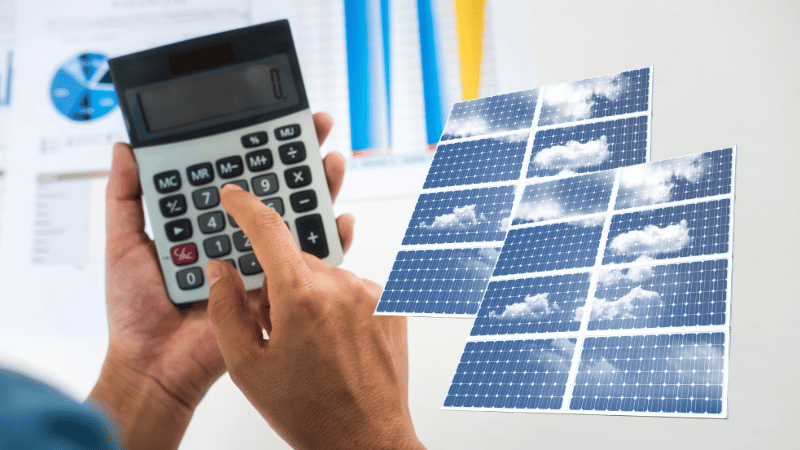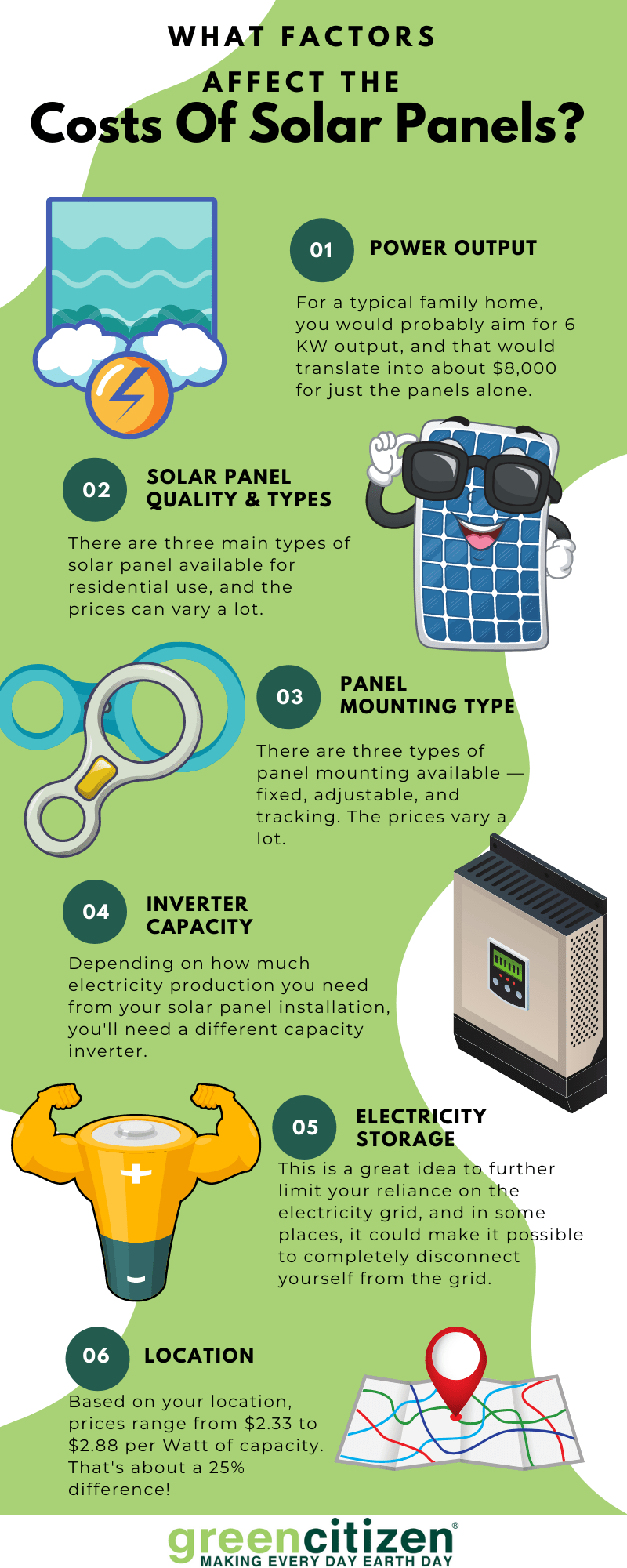If you’re considering installing solar panels, or upgrade an existing system, follow this guide to understand the real cost of solar panels.

Becoming more energy self-sufficient in 2024 is going to mean looking at installing or expanding a solar system in your home. My own experience with installing solar panels was initially mixed, but after having them for a few years now, I can definitely see their benefits.
The problem that many people face is that they look at the generally quoted costs of a solar panel system and simply dismiss it as too expensive.
But once you factor in state and federal tax credit availability and see the difference it will have on an electricity bill, then the light bulbs start to turn on.
So, whether you're trying to save the planet or are mainly considering a solar system to save money, it's important to understand how much they cost.
Let me show you what my recent experience and research have uncovered.
How Much Do Solar Panels Cost?
There are a few key factors that you have to account for that go beyond just the price of solar panels.
Also, keep in mind that we're looking at the costs of a residential solar system, not commercial ones.
Here's what makes up the total solar system cost.
Cost Of Solar Energy Systems
The most recent data from Consumer Affairs suggests that the average solar system costs about $16,000 before installation and federal tax credit. The solar panel system will include solar panels, wiring, and inverters.
Basically, it's all the hardware you need in order to install the solar panels on your roof and integrate it with your home.
This typical solar energy system will also not include rechargeable batteries that would allow you to store solar energy for use at night time.
Cost Of Additional Solar Panels
This was something that I was interested in about a year ago when I decided to expand my existing solar system. According to the Solar Energy Industries Association, prices have significantly dropped and thereby increasing demand for solar panels.
And since my initial solar installation a few years ago, the average solar panel cost has almost halved per KW. You can expect to pay about $200 to $250 per panel or about $1 per Watt.
Also, keep in mind that the varying solar panels cost you find online is entirely dependent on the efficiency rating, so always keep that in mind when comparing prices.
Another thing to keep in mind is that your inverter may limit how many panels you can install before you need to replace that too, which could range between $1,000 and $1,500.
Solar Panel Installation Cost
The labor costs of solar installers vary a lot from state to state.
It's typically about 10% - 20% of the hardware costs, and it obviously means that the larger and more complex the solar system becomes, the more time it will take to install it.
Tax Credits
The current federal solar tax credit until the end of 2033 is 26%. At present, the plan is to reduce that tax credit to 22% from 2034, which should work as an incentive to get your initial solar panel installation up and running this year.
The savings on an average solar system could be $1,000 extra if you take action this year.
That also has a significant impact on the payback period, i.e., how soon you'll have paid for the solar panels from savings on energy bills.
Buying Vs. Leasing Solar Systems
If a large upfront cost of $18,000 for a solar panel system is too much for you, then one option is to lease the system. This involves paying a monthly fee for having the solar energy system installed with a minimum lease period.
It keeps your upfront costs down, but you won't avail of the federal tax credit and won't get to a stage where you have fully paid for the solar panels.
More on this concept later.
Are Solar Panels Worth It?
This is what I've been asked by many friends and family. Many of them simply refer to the lack of efficiency on cloudy days or that the payback period would be too long because they use most of their electricity at night.
But most of those arguments are based on old solar technology standards.
Here's why I think a solar energy system is worth it.
Financial Savings
A modern solar panel system can easily produce enough electricity on a moderately sunny day to take care of all the energy needs of the home and even for a plug-in EV.
For a family of 4, that could mean a 6KW solar energy system, which would cost about $18,000. With households spending on average $120 per month, it becomes pretty clear how quickly you can save on electricity costs.
Yes, you won't pay off the solar system in a year or two. But as electricity prices keep going through the roof, you won't regret making that decision over the coming years.
And then there's the federal tax credit to consider.
Federal Solar Tax Credit
You will also get a federal solar tax credit of 26% of the solar panel cost. Let's say the average system costs $18,000; that's a $4,680 solar tax credit.
Bringing your tax bill down by that much will make the payback period a lot shorter. And considering that energy cost inflation is running at 6%, it won't take much longer for people to see serious savings.
There are also some local and state-level incentives available that could knock a further $1,000+ off the cost of solar systems.
Real Estate Value
You also have to factor in that solar panel installation costs directly influence the value of your home.
Some estimates indicate that a $500,000 home could increase its asking price by $20,000 after you install solar panels. That effectively means that your home is immediately about 4% more valuable, which is more than the average solar panel installation cost.
That really makes the solar panel cost and payback period a non-argument as your home immediately jumps in value.
Climate Benefits
And finally, for me, the most important reason to install solar panels was the impact on my carbon footprint and the climate.
By switching to an electricity provider that charges a little bit more per unit of electricity for 100% renewable energy supply, I have now got a system in place where my solar panels and outside electricity supply are 100% green.
And the great thing is that modern technology lets me see exactly how much renewable energy I'm producing each day and how much I'm getting from the utility company.
What Factors Affect The Costs Of Solar Panels?
Based on many hours of research and going through an installation and upgrade of a solar panel system, I can tell you that there are eight key influences when it comes to the overall costs associated with solar panels.
1 - Power Output
The biggest impact on your solar panel cost calculation will be how much energy you need to produce. For a typical family home, you would probably aim for 6 KW output, and that would translate into about $8,000 for just the panels alone.
Smaller households in places where it's not too hot in summer and not too cold in winter will probably get away with a 2 KW solar system.
There are also some economies of scale. For example, if you have two EVs and a household of 5 people in a warm climate, then you may need to go for a 12 KW solar power system. But because you're buying and installing more panels, it's possible to get discounts for such large installations.
2 - Solar Panel Quality
After the number of solar panels comes the quality of the solar panel you choose.
There are three main types of solar panel available for residential use, and the prices can vary a lot.
The cheapest types of panels use thin-film technology, and this is what you typically see for small consumer products like outdoor lighting or garden gadgets. They are a cheap type of solar panel but also very inefficient.
As a result, you'd need a lot more of them to get the same output as you would from newer technology.
The next step up is polycrystalline solar panels, and this refers to the use of different fragments of silicon. The approach is a lot less resource wasteful, but the solar power efficiency is still not maximized.
The monocrystalline solar panel is currently one of the best options available for residential and commercial use. They use single-crystal silicon, which creates a significant boost in efficiency. As a result, you'll need less of them on your roof, giving you scope to expand your solar system at a later stage.
These are, however, more expensive, but the investment could pay off very quickly.
3 - Panel Mounting Type
Most people will choose a fixed mounting on the roof. This is where the solar installer will pick the ideal side of the roof for maximum sun exposure during the day, and then each solar panel is fixed in one place.
These mounts typically cost about $20 each.
Then there are adjustable mounts, which cost $50 each, and they allow you to adjust the angle of the solar power panels depending on the time of year. However, this still requires a manual adjustment but could boost your solar energy production in midsummer and midwinter.
And then there are the tracking mounts. These typically cost $500+ per panel, and they automatically align the panel with the sun for maximum solar energy production. I haven't seen these installed for a residential solar panel installation and would imagine that they require a flat roof to work.
They are also only suitable where you have a lot of sunshine all year round, for example, in places like Arizona and Nevada.
4 - Inverter Capacity
Depending on how much electricity production you need from your solar panel installation, you'll need a different capacity inverter.
The inverter transforms the direct current (DC) that comes from the panels into alternate current (AC) that your household appliances need. And every converter can handle a maximum KW capacity before it runs the risk of catching fire.
Many people will try to keep the cost of solar energy systems down by only investing in the minimum size inverter. This does keep the costs down, but it limits your ability to expand solar panel systems with additional capacity at a later stage.
5 - Electricity Storage
The next thing that has a significant impact on the cost of a home solar system is if you want to store excess capacity during the day to use it at night.
This is a great idea to further limit your reliance on the electricity grid, and in some places, it could make it possible to completely disconnect yourself from the grid. Essentially, you'd never get another utility bill again.
However, battery storage isn't cheap, and to go completely off the grid, you'd need enough storage to keep you going for several days. In places like Arizona, that's achievable since it's realistically not going to be completely overcast for a long time.
The cost of solar energy storage will typically start at about $2,500 for a relatively small battery system. And just like with EVs, it will go up a lot the more storage you want to add.
6 - Selling Excess Electricity
Another option that has become increasingly available throughout America is the ability to sell your excess solar energy production back into the grid. So, when you're not at home and the system is working at its peak, you can feed that electricity back into the grid to be used by other households and businesses.
This is a solution that hasn't been rolled out everywhere. And there are differences in what utility companies offer. Some will give you a 1 to 1 credit for each unit of electricity, while others will pay you a set rate per KW.
It's a great way to further reduce your electricity bills.
7 - Location
As with many other things in life, your location in America will also impact the cost of solar installations. In order to get a like-for-like comparison, it's best to look at the per-watt cost in different states.
Based on data provided by ConsumerAffairs.com, prices range from $2.33 to $2.88 per Watt of capacity. That's about a 25% difference.
The cost of labor will also vary from state to state, so you need to keep that in mind as well.
8 - Tax Rebates And Incentives
And finally, we have to look at tax incentives and solar tax credits available.
Everyone is able to get a 26% federal tax credit until the end of 2033. From 2034, that federal tax credit will reduce to 22% of the installation cost.
But there are also local incentives at both the state and municipal levels as well. Some towns have introduced programs where they offer several hundred dollars for each home and business that makes the switch.
It's always important to check for your local state and county incentives, as these can all add up to a significant saving.
Let's Calculate The Overall Cost Of *YOUR* Solar System
OK, so with all that information above, what does this actually mean for your overall solar panel cost in your specific home?
To help you get a rough idea, I'll walk you through a few steps to make the solar panels cost calculations.
Cost Of Panels
The first thing to work out for your solar panels' cost is how much electricity you need to generate. Let's say you have a family home with four people and you're careful enough with your electricity usage.
You'll probably have a monthly usage of about 900 kWh or 30 kWh per day.
To work out how much energy you need to be able to produce, you divide your daily consumption by. This is a very rough guide as the real calculations are very complicated.
So, for the average home, that will mean a solar power capacity of 6 kW or 6,000 Watts.
For a high-efficiency solar panel, you need to budget about $1.50 per Watt. As a result, we can calculate what the panels alone will cost.
Cost of Panels
6 kW output panels = $9,000
Cost Of Integration System
The next thing you'll need for your residential solar panels is the mounting brackets and the inverter to connect to your home.
For the above 6 kW output, you'll end up with about 25 individual panels, and each mounting bracket will cost about $20.
You'll also need to budget about $1,000 for cabling and connections.
The more expensive part is going to be the inverter that converts DC to AC power. For a 6 kW capacity inverter, you'll probably pay about $2,000. But as mentioned above, that doesn't give you any room for later upgrades.
It would make sense to take advantage of federal tax credits and local tax incentives to buy a system with twice the capacity. This isn't going to double the price, and you should be able to buy one for about $3,000.
Cost of Integration System
Mounting brackets = $500
Inverter = $3,000
Cabling = $1,000
Installation Costs
The labor costs for solar installers vary from state to state, and then you have to also factor in that the size of the system will dictate the total amount of labor hours needed.
A good way to approach this is to budget for about 20% of the hardware costs for labor, which is what the Solar Energy Industries Association recommends.
So, for our above system, that will mean about $3,000 for installing solar panels.
Installation Costs
Labor = $3,000
Tax Rebates
Calculating the federal tax credit is actually very easy. It's a lot more difficult to give you an idea of how local incentives could impact your total price as those tax credits vary a lot from county to county.
But based on the above solar costs, we can say that our total system installation will come to about $16,000, and 26% of that is easy to calculate.
This will be assigned to you as tax credits that reduce your federal income tax liability.
Tax Rebates
Federal Tax Incentives = -$4,160
Total Cost Of Solar Installation
OK, let's pull all those details into an easy-to-read table.
Description | Cost |
|---|---|
6 kW output panels | $9,000 |
Mounting brackets | $500 |
Inverter | $3,000 |
Cabling | $1,000 |
Labor | $3,000 |
Federal Tax Incentives | -$4,160 |
Total | $12,340 |
This would be for a typical residential family home. For larger systems to support very large homes, the solar panel costs won't necessarily double, as there are some economies of scale involved.
But such larger systems that approach a commercial scale should always be discussed with a professional installer to carefully calculate the exact energy costs.
Maintenance Costs
One other thing that I should mention here is that you also need to factor in an annual inspection into the cost of solar systems. This will typically be about $150, and you need to consider that when you're calculating the return on investment and payback periods against your energy bills.
It's not a significant cost, but doing this will make sure that you're system is operating efficiently and safely.
Should You Buy Or Should You Lease? Which Is the Cost-Effective Route?
Most people will think about buying a solar power system and then see the full solar cost and then get discouraged. If such a large upfront investment is difficult for you to achieve, then you should carefully consider solar panel costs associated with buying and leasing.
Both have their advantages and disadvantages.
Advantages and Disadvantages of Buying Solar Panels
Pros
Cons
Advantages and Disadvantages of Leasing Solar Panels
Pros
Cons
6 Solar Installation Tips You Should Follow
Here are 6 final tips I would give you to make sure that you get the most cost-effective solution.
1 - Choosing A Brand
This is possibly going to be one of the toughest decisions because there are a lot of companies producing and installing solar power systems. And like with everything else in life, some companies with decades of experience will charge more for the brand name.
Just like a Caddilac costs more than a Ford.
One thing I would suggest is not to go with the newest brands. There are countless new companies out there, and experience plays a critical role in quality, efficiency, and durability.
So, research a few local suppliers and find out how long they have been in operation, and then balance the price and experience levels.
Read More:
2 - Financing The Cost Of Solar Power
The upfront cost of solar installations could be in the region of $18,000. That's a considerable amount of money for most people to come up with.
However, with interest rates still at record low levels, it should be possible to get the full amount financed through your mortgage or a separate home improvement loan.
Some lending providers will even offer discounted rates for energy efficiency solutions because they increase the value of a home.
Start by contacting your mortgage provider and your bank. And get some quotes from a financial broker as well, as there could be much better deals out there.
3 - Finding All The Tax Incentives
For details on the federal tax credit, you're best off starting with the government website that tells you exactly what you need to do to apply for it. If you have an accountant that takes care of all your tax affairs, then you can ask them to take care of it as well.
It's a bit more difficult to find all the state and local incentives available.
The best thing you can do is run separate searches for your state and county with the keywords "solar panel tax incentives" and "solar panel funding." For example, you would search for "Maine solar panel tax incentives" and "Lincoln County solar panel funding."
You'll be surprised how many local taxes and incentives there are to bring your cost of solar installation down.
4 - Future Proof Your System
When you're hiring an installation company, make sure you spend some time with the solar panel consultant about the best future-proofed system.
Here's why that matters.
I originally installed a small 2kW system, and when it came to upgrading it, I could only initially go as far as 3kW. The reason was that my inverter was too small, which meant a further investment.
If you start with a system that you can expand over time, then you'll keep future upgrade costs down.
5 - Selling Excess Energy Production
Call all the available electricity supply companies in your area and find out which ones offer to buy your excess electricity production or offer a rebate.
You're going to have days when your peak production happens when you're not at home. And being able to not waste that electricity or investing in batteries can significantly lower your energy costs.
It's still not something that is offered by all utility companies, but it's worth finding out before you get your installation done.
6 - Keep Your Solar Panels Clean
This is quite an important tip, especially for people who live in areas that are dry for most of the year. Dust will settle on the panels, and that will reduce the efficiency.
In places where it rains regularly, even in summer, this really isn't much of an issue.
But if you've had a few weeks with no significant rainfall, then I would suggest that you get a sweeping brush or hose down the panels to keep them clean.
Final Thoughts
Yes, the upfront cost of investing in solar panels isn't going to be cheap. But considering that your real estate value will jump by 4% and that you'll immediately enjoy a much lower utility bill, it should be enough of a financial incentive.
Once you add in all the tax incentives and other funding available, the costs will come down a lot.
Most importantly, though, you'll be making a significant improvement on climate change and setting an example for your family, friends, and neighbors to follow.
If you have any further questions, then post them in the comments below, and we'll make sure that we point you in the right direction.













Thanks for sharing this insightful walkthrough on the cost of solar panels in 2022! Understanding the financial aspects of transitioning to solar power is crucial, and your guide breaks down the complexities effectively. The detailed information on factors influencing costs provides a clear roadmap for those considering renewable energy solutions. Great job!